Last updated on November 22nd, 2023 at 13:19
Thinking of a new coffee brewing tool and can’t decide the winner between a French Press Vs Stovetop Espresso, then this article is for you. Let’s be clear this is not a battle between espresso machines as neither truly makes an espresso as they are missing the pressure needed to make a true espresso.
One thing is for sure is you will get great strong coffee from both.
It is not my prerogative to tell you which one you should get; this article is designed to inform you about both and leave it up to you what to decide.
There may be a little wiggle room for my opinion and thoughts based on my expertise and opinion. This is not intended to influence you in any way.
What Is A Moka Pot?
Table Of Contents
- 1 What Is A Moka Pot?
- 2 What Is A French Press?
- 3 French Press Vs Stovetop Espresso Maker: The Manual Brewing Methods Explained
- 4 Brew Time: Stovetop Espresso Moka Pot Vs French Press
- 5 Budget Battle: Which Is The Budget Buster?
- 5.1 Construction Material
- 5.2 What Kind Of Coffee Should I Use?
- 5.3 Do Stovetop Espresso Makers Make Good Espresso?
- 5.4 Is A French Press Good For Espresso?
- 5.5 Is Espresso Stronger Than French Press?
- 5.6 Can I Use Starbucks Ground Coffee In A French Press?
- 5.7 Is French Press As Good As Espresso?
- 5.8 What Is The Difference Between A French Press And A Stove Top Espresso Maker?
- 6 Frequently Asked Questions About French Press Vs Stovetop Espresso
- 7 Frappé-Ing It All Up – French Press Vs Stovetop Espresso
The Moka Pot, a classic way of brewing coffee and loved by many and sworn to by millions of Italians the world over as a great way to brew coffee. The Moka pot, invented by Mr. Alfonso Bialetti in 1933, whose company Bialetti still makes the device today.
The device that he, an Italian engineer, designed, was originally used with aluminum and a heat-resistant Bakelite handle. Moka Pots are now made today from a variety of materials, with stainless steel being the most popular alternative.
The common size of a moka pot ranges from a tiny 1 ounce (60ml) to an ample 12 ounces (480ml). There are larger versions, but they are far less common.
The functionality of the moka pot brewing technique is very easy to understand and no degree in mechanical engineering or steam engineering is required. It functions on the principles of Darcy’s law and Ideal gas law.
To be clear, and dispel a myth or two, a moka pot does not need to boil the water from the water chamber. The expanding gas (air) in conjunction with the vapor pressure from the water is enough to push the water up, into and over the coffee grounds and into the coffee chamber.
The boiler, the chamber that you fill with water, is filled to a level that is just below the safety valve. You then place the metal filter funnel in place with your coffee grounds in it. This is your filter basket. It is not only Italians, but literally nobody pre-heats their water and only uses cold water from the tap.
Physicist Warren King and well-known baristas Tristan Stephenson and James Hoffman recommend using pre-heated water as cold water does not reach the higher temperatures and results in a lower temperature extraction of your coffee. Conversely, too high an extraction results in too high a temperature of vapor for extraction of the coffee oils and flavonoids.
70C (158F) is the ideal temperature to get the perfect extraction temperature.
The gasket in a moka pot is there to ensure a tight fit and that pressure builds up when the water warms. Should the pressure get too high, the safety valve opens and releases pressure.
The ground used for elaborating coffee with this method is finely ground coffee. With the moka pot, how tightly you compact the grounds affects the brew time.
A moka pot can come in an electric version as well as the traditional stovetop. The advantage of the electric version is the function to keep your brew warm. Often, a Moka pot is called an Italian espresso machine.
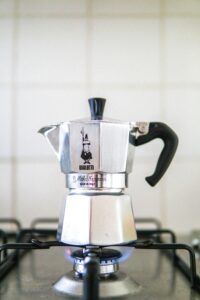
Read: Stovetop espresso maker stainless steel vs aluminum
What Is A French Press?
Perhaps the center piece of French coffee culture is the French press.
The French press goes by many other names, and thus you may know it by another name. In Italy, it is known as a stantuffo or caffettiera. In South Africa, it is known as a plunger coffee or a coffee plunger. In Germany, it is a literal translation Stamp pot or a Coffee press, (Stempelkanne and Kaffeepresse, respectively). In France, it is known as a cafetière or a cafetière à piston. In the Netherlands it is known by trademarked names Bodum or Melior.
In my native United Kingdom, it is known as a cafetière.
The French press, like the Moka Pot, was invented by an Italian, two Italians to be exact. Giulio Moneta and Attillio Calimani in 1928. The design is based around and is closely similar to a device used to make tomato juice and adapted the pressing action and filter to function as a press action coffee brewer.
The brewing process of a French press is very easy to understand as it is a hot water full immersion technique. It is a very simple brewing method that, like the moka pot, extracts all the coffee oils from your freshly ground beans with no paper or cloth filter to prevent or inhibit the oils and coffee compounds from making their way into your brew.
The ideal brew temperatures of a French press is 199F to 205F (93C to 96C) with coarsely ground coffee beans. The grounds are usually bloomed to allow the degassing of the grounds prior to a 4 min to 5 minute brewing time. Slow plunging is highly recommended over fast plunging for better extraction.
Once brewed, you must remove the grounds and not allow the grounds to overbrew the coffee that is in the chamber.
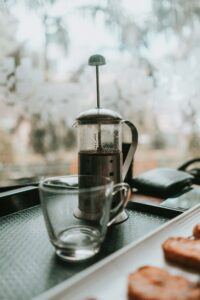
French Press Vs Stovetop Espresso Maker: The Manual Brewing Methods Explained
Both the French press and a Stovetop Moka pot (or electric Moka Pot) are manual brewing methods that use hot water – for best results.
Let’s detail those and help you decide which is better for you.
How To Use A French Press Coffee Maker
When it comes down to serious brewing, as serious coffee lovers, we need to use the right tools for the right job and that involves using the right ratios for the brew method that you are using. This involves weighing both your water and coffee grounds.
At Latte Love Brew, we highly recommend that you grind and roast your own beans for maximum freshness.
This method for brewing coffee requires a 1:12 coffee to water ratio. Let’s say you are making an ample 16 ounces (480ml) of coffee. Your water weight of 480 grams will require 40 grams of freshly ground coffee.
Water is something that you can control by using soft water or bottled water for brewing for best results. Heat your water to an almost boiling point of 205F or 96C. If you have no thermometer, boil your water, then let it sit for 30 seconds.
Now put your coffee grounds into the French press, give it a shake to even out the distribution of your grounds. Pour some hot water on to the grounds until they are damp. Pour in an even manner. Let your grounds bloom for a minute or two. This is simply allowing them to degas, to bubble a little. Then fill the chamber with water slowly.
Put the lid on and slowly push down the plunger to just below the water level. Let your grounds brew for 4 minutes to 5 minutes. Use my golden rule of TAFO – Taste And Find Out.
Taste a little after 3 min, if it is hitting your sweet spot taste, great. If it is not quite ready, let it brew for a minute more and repeat the test until it hits your personal preference. When your brew is ready and perfect. Press down slowly on the plunger, making sure the plunger is in place when you pour your cup of coffee.
If you have any coffee left, decant it and save it for later. Do not let it sit in your French press as it will start to overbrew, and you will end up with a bitter coffee.
How To Use A Moka Pot
To make a delicious coffee that even the best coffee fanatic will be delighted with, you will need to adhere to the ratio of coffee to water for this Italian coffee maker, which is 1:7. Let’s assume you have your hands on a rather large moka pot of 16 ounces.
For a moka pot of this size, 480ml 16 ounces, you will need to use 480 grams / 7 = 68.6 grams of finely ground coffee.
The grind size, as mentioned, is a fine grind, not a very fine espresso grind by a fine grind that is just a little bigger than granulated sugar.
Now, for best results, preheat your water to 70C (158F). This is the ideal water temperature for starting the brewing process to ensure that you are not getting too cool water vapor or too hot when the extraction of the flavonoids and coffee oils is taking place.
Put your 68.6 grams of coffee and put them into the small mesh filter basket. Level the grounds for an even brew. Do not tamp your grounds. This is not required at all for this type of coffee maker.
Now screw your moka pot together tightly. And place on your stove. Let your Italian coffee pot brew. As it does, the preheated water will start to produce vapor and a stream of coffee will make its way into the upper chamber for coffee. Your coffee is ready when you hear a familiar percolating sound.
Simply remove the heat, switch off your stove. Pour yourself a coffee and enjoy the taste of stovetop espresso.
Many coffee novices have made the mistake of referring to ta moka pot as a stovetop espresso machine.
A moka pot does not produce the water pressure required to make an espresso (29 PSI Vs 130 PSI). To be fair, the brew method is probably as close as you can get with a home brewer that is not an actual espresso machine, and you can get some crema.
At push, you could call a moka pot an Italian espresso maker. I prefer to call it an Italian coffee percolator as the extraction method resembles this method a lot closer. I will be fair and admit that you can get a near espresso quality extraction, you are just missing a more dense crema.
Like the French press, here in Europe it is easy to find an artisan coffee shop with both a French press and a moka pot.
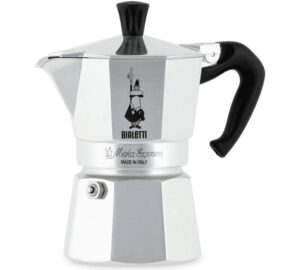
Brew Time: Stovetop Espresso Moka Pot Vs French Press
While as detailed above, one uses immersion brewing and the other a pressurized steam vapor brewing technique, both produce a quality pot of brew in a relatively short time. Both take only a few minutes, typically around 4 minutes.
With the Moka pot you don’t have too much control over the strength of your brew as once it is in the upper coffee chamber that is it, no way of making it stronger by brewing longer.
With the French press, you can allow it to brew for a longer time, a few minutes more for a stronger brew or a more punchy brew depending on your own personal preference, and get the perfect brew as per your own exact taste.
Brew time and prep time are not deciding factors, neither should be the brewing technique, difficulty level or convenience. Both are incredibly easy and ideal for novices and those just starting their coffee adventure.
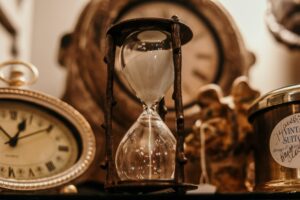
Adaptability To Personal Taste Profile
The moka pot is very much a semi-automatic coffee brewer where you have little input, pretty much like a standard drip coffee maker. You just pre-heat the water, add the coffee and that is about as far as your input to the process goes other than grind size the coffee beans and roast.
A French press, on the other hand, is one of the few brewing methods that gives you full control of all the variables in the brewing process, from brew temperature to the extraction time and everything in between. This is what makes the French press perfect for your fancy expensive single origin coffee beans.
Brew Quality And Taste: French Press Vs Stovetop Espresso Moka Pot
This one is all about your own coffee preference.
Here is my own take and analysis of both of these methods of elaboration produce very different tasting Cuppa Joe’s. A French press is rich in texture, full-bodied and exact to your preference. A stovetop moka pot is sharp, strong, full-bodied and energizing, more overpowering than a French press.
Budget Battle: Which Is The Budget Buster?
There is no real budget buster here. Regardless of the size and capacity of the coffee brewer in question, large or small, there is not much of a difference in price between Moka Pots and a French press.
You can buy either a quality French press or a Moka pot for less than US$40. Both will last you for a very long time, a few years each easily.
You can splurge on more expensive ones if you so wish. That is your own choice. If it is an electric moka pot that you prefer, these too still fall in the US$40 price mark.
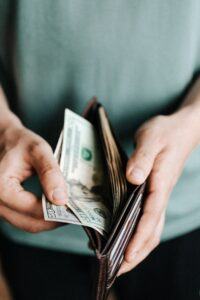
Construction Material
You can find French presses made out of a combination of glass and metal. Some you will find made entirely of plastic, some a combination.
I advise you to avoid one that is made of plastic or has plastic parts. Plastic is a porous material and will negatively affect your coffee taste.
Also,
this material contains Xeno-estrogens that will leak into your coffee due to both the high temperature of the brewing process and the acidity of your coffee. Look for a glass and metal combination or an all metal combination of materials.
Moka pots, both stovetop and electric, are made predominantly of aluminum or stainless steel. An aluminum one will get you a better, more even heat distribution and I advise against this material type to avoid heat spots and an uneven brewing which will spoil your coffee.
Most electric moka pots are made of aluminum base and have the coffee chamber made of thermoplastic. Watch out for that.
Plenty of coffee aficionado will miss this detail regarding plastic, not me. Call me a coffee snob if you may, but I am a stickler for details and a scientific approach to what can affect your coffee.
What Kind Of Coffee Should I Use?
As a gourmet coffee lover, you will enjoy and get the best out of your beans with a French press than a moka pot. You can use your choice of gourmet coffee with a French press and fully enjoy it. I, personally, have a preference for brewing my best beans with a French press.
For your moka pot, dark roasted coffee and espresso roasts, French and Italian roasts work well to get a full-bodied, full intensely finished coffee that is full of flavor. A moka pot, to be clear, is not for your gourmet beans.
In all cases, I advise you don’t use pre-ground coffee and grind and roast your own beans for maximum freshness.
Do Stovetop Espresso Makers Make Good Espresso?
Stovetop Espresso Makers (AKA Moka Pot) do not brew an espresso. The actual extraction lacks the pressure to result in full-on espresso. You can still get a good strong full-bodied coffee with a touch of crema but due to the weak extraction you are missing a lot of the thick crema. It is not bad, at all as far as a making an espresso without an espresso machine goes.
Is A French Press Good For Espresso?
No,
in the espresso making battle between these two brewing methods, a French press fails miserably. You simply cannot make anything that resembles an espresso with a French press. For sure, you can use a French press to brew espresso beans, but you will end up with zero crema.
Is Espresso Stronger Than French Press?
Yes,
an espresso is a very strong, focused and concentrated black coffee and has more caffeine per ml or ounce, but over all, a French press coffee contains more caffeine on average in an 8 ounce cup, almost twice as much as a single shot espresso.
Can I Use Starbucks Ground Coffee In A French Press?
Absolutely!
But I advise you not to! Only because I advise you to buy Starbucks whole bean coffee. If you are going to spend good money that you have worked hard for on great coffee, then get the absolute best out of them by grinding them fresh right as you are about to use them.
You can also use the finer dark roasts from Starbucks in a Moka pot.
Is French Press As Good As Espresso?
In my opinion, yes, a French press is every bit as good as an espresso. It brews a different type of coffee, one that has more body and less acidic and is ideal for medium roast, medium-dark roast and dark roast coffee.
What Is The Difference Between A French Press And A Stove Top Espresso Maker?
A French press coffee maker and a stove top espresso maker produce two very different types of coffee. Your moka pot will brew a small, strong and sharp coffee that goes great with milk and cream. A French press brews a larger cup of coffee with a rich texture and full-bodied.
Frequently Asked Questions About French Press Vs Stovetop Espresso
Is French Press Better Than Espresso?
What is better is subjective and entirely opinion based. Each brewing method produces a different tasting cup of coffee. It is a matter of matching a particular coffee bean or roast to a brewing method and the type of coffee beverage.
For specialty coffee of a medium roast and above, a French press is an excellent brewing method and is better than espresso in this aspect.
However, if you want to make espresso-based beverages like a latte, mocha, macchiato, cortado, cappuccino, and espresso shots, an espresso machine is better, much better.
Are French Presses Good For Espresso?
No, a French press is not good for making an espresso shot. A French press cannot produce the necessary amount of pressure to produce a thick crema on top. You need 9 bar of pressure (130 PSI).
You’ll get a good quality and tasty short espresso like coffee but not an authentic shot of espresso.
Is a Moka or French Press Better?
It depends on which type of beverage that you want to make and the beans that you are using. if you want to make specialty coffee, a French press will extract the flavors better than a moka pot. If you want to make espresso like beverages and milk based espresso drinks at home, a moka pot is the better choice.
Can You Get Crema With French Press?
No, you cannot get crema with a French press. The reason why is due to a French press not being able to produce enough pressure. You need 130 PSI (9 Bar) of pressure to produce a thick rich crema on top.
The thick crema on top is a result of fresh oily beans and the water pressure and temperature. When you are missing one of those elements, you will not get that crema.
A French press cannot produce the pressure needed to achieve a creama of any description due to the lack of pressure.
Do Italians Use Bialetti?
Yes, Bialetti is one of the most popular manufacturers of coffee brewing equipment from espresso machines to Moka pots and are very popular in Italy. Every Italian family has a Bialetti somewhere in their home.
Do Moka Pots Make True Espresso?
No, despite being labeled as stovetop espresso machines a moka pot cannot make a true espresso for the same reason that a French press can’t – it cannot achieve enough pressure to produce the thick, rich crema on top.
A moka pot can only produce 1-2 bars of pressure, which is far short of the 9 required.
Frappé-Ing It All Up – French Press Vs Stovetop Espresso
In the battle of the brew of French Press vs Stovetop Espresso you have all the information that you need to make a good proper and educated choice if you need to decide between the two. I have both just, one I own, the other came with my rented Spanish apartment.
When I want a strong punchy brew it is the Moka pot, when I want a great full flavored brew from my specialty single origin beans it is the French press that I use. What you want to get your hands on will depend on what you want it for and what type of coffee to make.
Join our online coffee community on Facebook/Meta and tell us which wins out for you: Moka pot or French Press?.


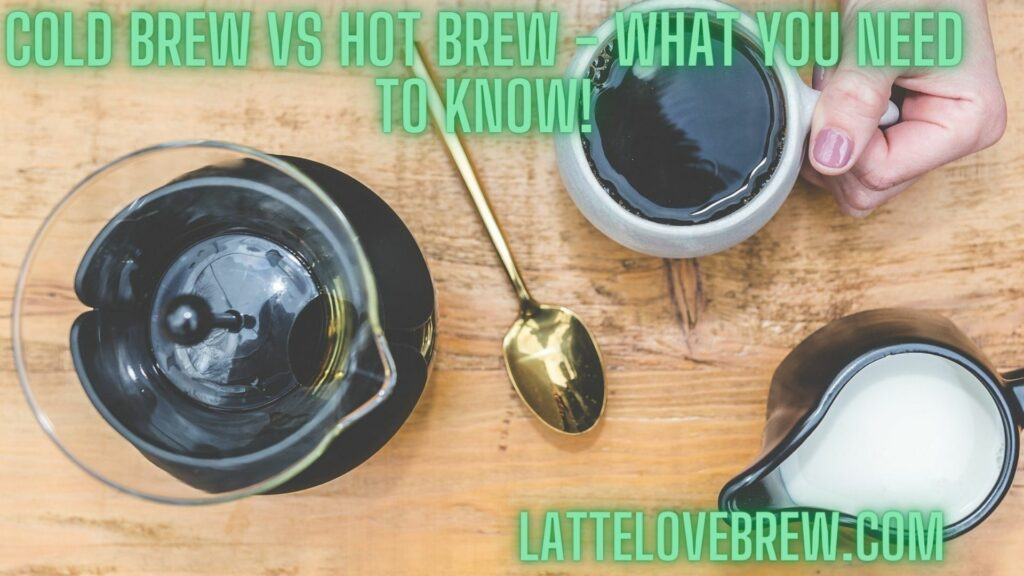
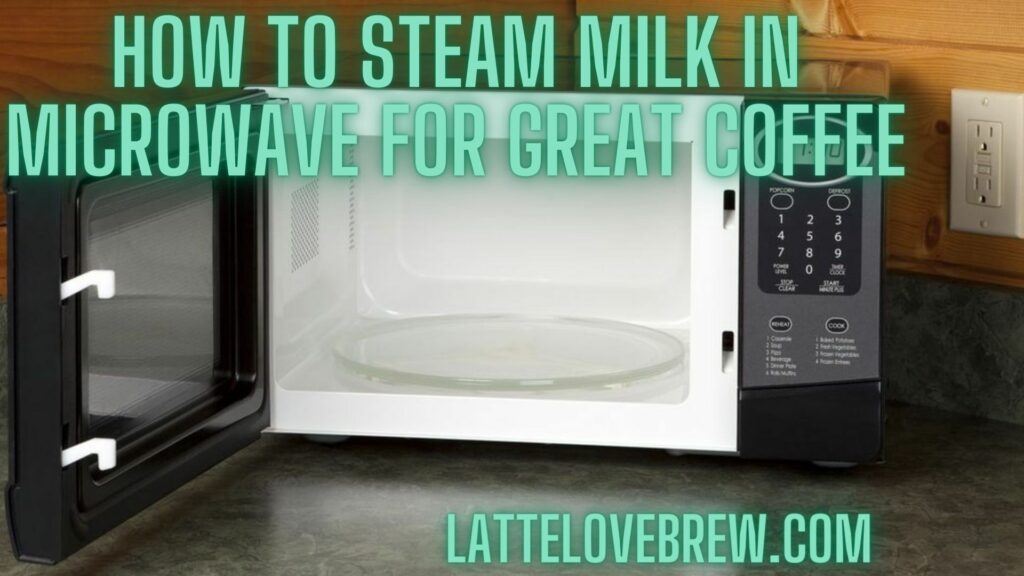

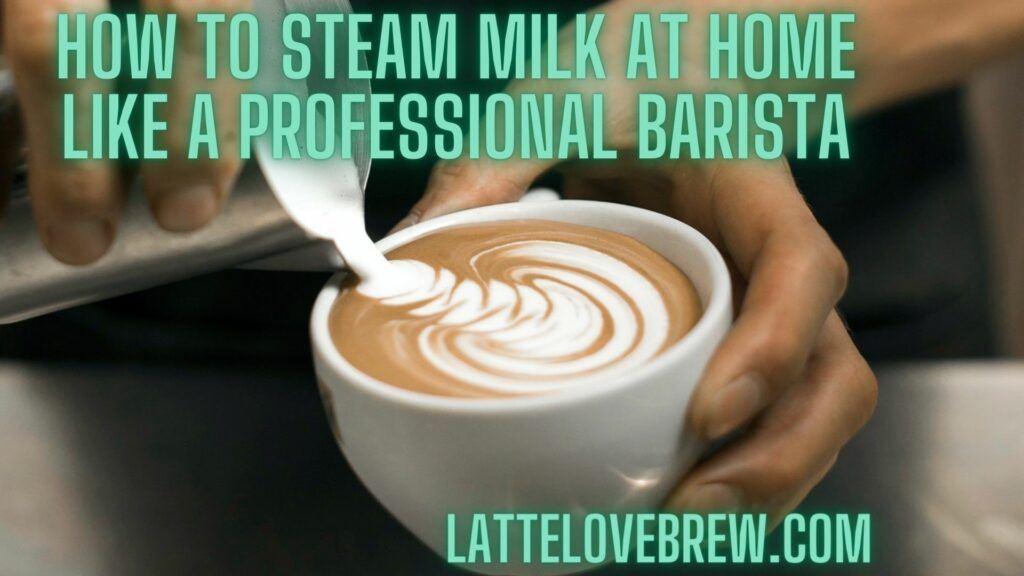
![[Recipe] How To Make Dunkin Iced Coffee At Home Like A Pro!](https://lattelovebrew.com/wp-content/uploads/2022/04/Recipe-How-To-Make-Dunkin-Iced-Coffee-At-Home-Like-A-Pro-1024x576.jpg)
